During week four I got access to the force plate with Professor Khetan. The force plate gave me good preliminary data for this project. The reason why this is preliminary data is because the sampling rate of the force plate is low (permanently set at 10 samples a second) and the plate is elevated off of the ground. The data will still help me make my decision in how I want to differentiate between a ball and a person.
Above is the scatter plot of a run over the force plate. The force goes up to 1200 newtons and the estimated duration is 0.3 seconds.
Above is the plot of a hard volleyball hit on the force plate. The force only goes to 3.5 newtons and the estimated duration is about the same at 0.3-0.4 seconds.
In the spring, I estimated that I could tell the difference between a ball and a person by the duration of each contact. After these results I still believe that is the best way. The force plate is not extremely accurate due to the sampling rate. The only way to confirm my estimate is to further test with the FSR’s. Obviously magnitude is an easy way to differentiate between the ball and a person but FSR’s are limited in how much force they can detect. This will also be further investigated with the FSRs.
Though these results did not give much insight into differentiating between a ball and a person, it did give insight to what I need for the sampling rate. Clearly the 10 samples a second is too low for this application, therefore I estimate that I need at least 5 times as much as the force plate. 50 samples a second would give me a much better reading on the duration of the impact. The Arduino MEGA 2560, my preliminary choice for a microprocessor, has a large sampling at 16 MHz. This is clearly enough for this project now confirming that this microprocessor is a good choice.


